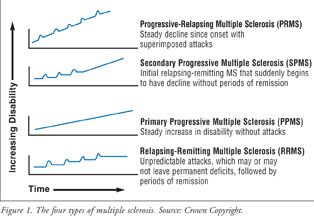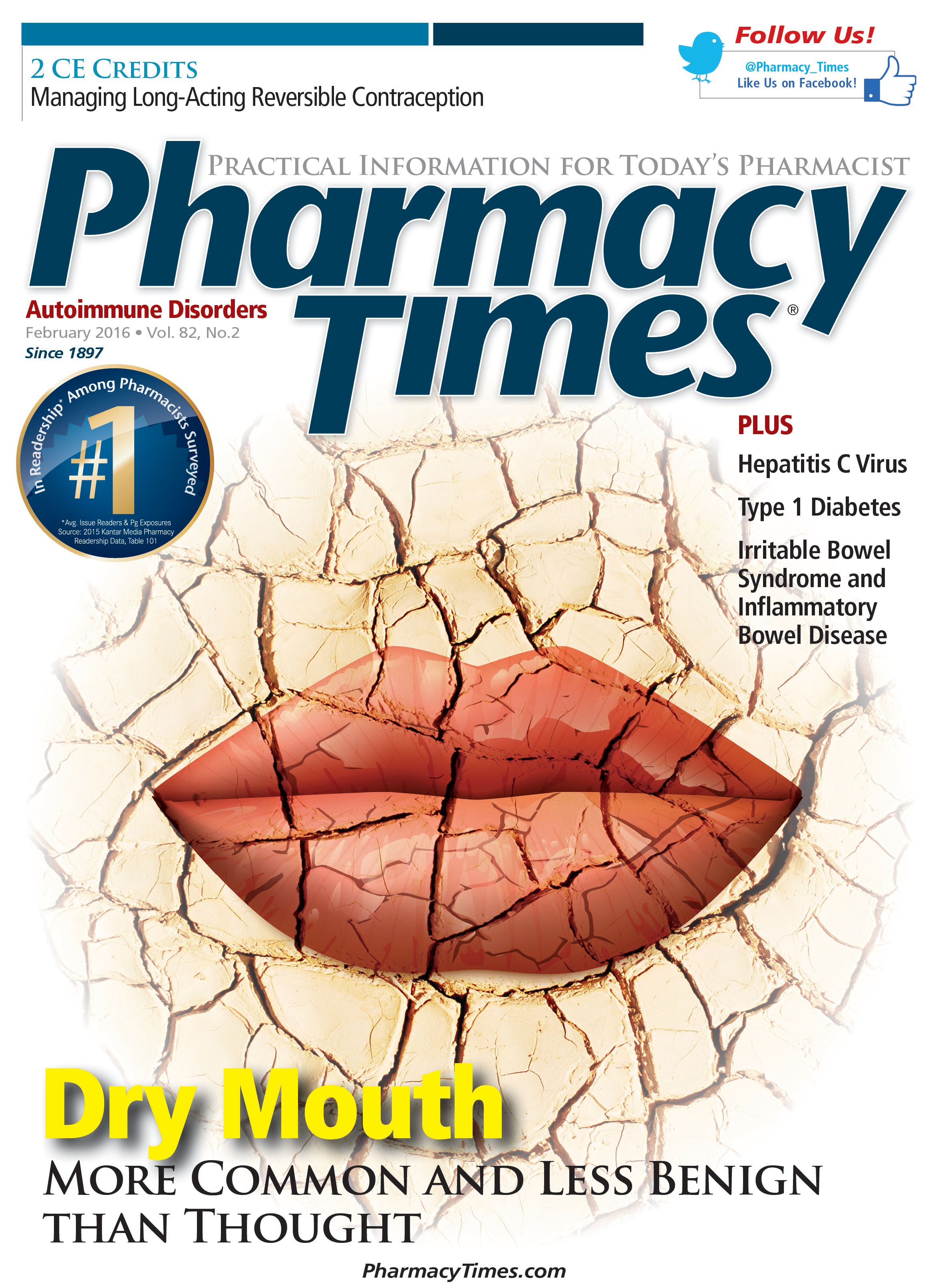Publication
Article
Pharmacy Times
Managing Multiple Sclerosis: The Pharmacist's Expertise
Author(s):
Multiple sclerosis is a chronic autoimmune, inflammatory neurologic disease of the central nervous system that affects more than 400,000 individuals in the United States and 2.5 million individuals worldwide.

Multiple sclerosis (MS) is a chronic autoimmune, inflammatory neurologic disease of the central nervous system (CNS) that affects more than 400,000
individuals in the United States and 2.5 million individuals worldwide.1-3 In MS, the immune system attacks the protective sheath that covers the nerve fibers and causes communication issues between the brain and body.2 MS is frequently identified in women, Caucasians, and persons of Northern European descent, especially Scandinavians. It usually presents between 20 and 50 years of age, with the average age of onset being approximately 34 years.4
Currently, there is no single test for the diagnosis of MS. Several strategies are used to determine if a patient meets certain criteria for a diagnosis of MS, while ruling out other possible causes of symptoms the patient is experiencing.1 The typical clinical findings include optic neuritis, diplopia, heat sensitivity, limb numbness, and Lhermitte’s phenomenon.2,5 The 4 types of MS are based on the course of disease: relapsing-remitting MS, primary-progressive MS, secondary-progressive MS, and progressive-relapsing MS1 (Online Figure; Table 1).

Treating MS
Currently, there is no cure for MS. The goals of therapy include shortening the duration and frequency of acute exacerbations and relapses. Therapy is also aimed at providing symptom relief, slowing progression, providing emotional support, and enhancing quality of life.2,6
Management of Acute Exacerbations
An exacerbation is caused by CNS inflammation, which damages myelin.6 Exacerbations are defined as the worsening of an MS symptom and/or the appearance of a new symptom that lasts at least 24 hours and is separated from a previous exacerbation by at least 1 month. For exacerbations requiring treatment, corticosteroids are ordinarily used to minimize the duration and the long-term sequelae.7
Disease-Modifying Therapy
Disease-modifying drugs (DMDs) are used to decrease the frequency of acute attacks and prevent long-term disability.1,8 Selecting a particular medication from among the various FDA-approved DMDs requires comprehensive knowledge of the patient and the available medications. Appropriate selections should encompass patient preference, potential efficacy, risk of adverse effects (AEs), and the patient’s health care insurance provider.8,9
The FDA-approved DMDs for managing MS may be available as injectables, oral medications, or infusions. Patients with a new diagnosis have historically been started on injectable formulations (Online Table 2), which have been proven effective in reducing the frequency of relapses.8,9 The interferons in this class have most commonly been associated with flu-like symptoms, which are often managed with ibuprofen or acetaminophen and may lessen over time. Patients who are taking glatiramer acetate are advised to use proper injection technique and rotate injection sites to minimize the risk of injection-site reactions.8,9
Table 2: FDA-Approved Disease Modifying Agents (Injectable Agents)
Drug
Dosage
Adverse Effects
Patient Support
Glatiramer acetate (Copaxone, Glatopa)
Daily 20- mg SC injection or 3-times-a-week 40-mg SC injection
Injection site reactions
Copaxone Shared Solutions copaxone.com/AboutSharedSolutions.aspx 800-887-8100
Interferon beta-1a (Avonex)
Weekly 30-mcg IM injection
Flu-like symptoms following injection, which may lessen over time
Avonex MS ActiveSource
avonex.com
msactivesource.com
800-456-2255
Interferon beta-1a (Rebif)
3-times-a-week 44-mcg SC injection
Flu-like symptoms following injection, which may lessen over time
Rebif MS LifeLines
rebif.com
mslifelines.com
877-447-3243
Interferon beta-1b (Betaseron)
Every-other-day 250-mcg SC injection
Flu-like symptoms following injection, which may lessen over time
Betaseron BETAPLUS
betaseron.com
800-788-1467
Interferon beta-1b (Extavia)
Every-other-day 250-mcg SC injection
Flu-like symptoms following injection, which may lessen over time
Extavia
extavia.com
Extavia Go Program
866-398-2842
Patient Assistance NOW patientassistancenow.com
800-245-5356
Peginterferon beta-1b (Plegridy)
Every 14 days 125-mcg SC injection
Flu-like symptoms following injection; injection site reaction
Plegridy MS ActiveSource plegridy.com
msactivesource.com
800-456-2255
IM = intramuscular; SC = subcutaneous. Adapted from reference 9.
With the introduction of oral DMDs (Online Table 3), patients with MS have been provided with a more convenient option for managing their disease. Barriers to the use of these medications are high cost and lack of medication adherence.6 The importance of taking these medications, which are not free from AEs, should be stressed to patients so they do not stop taking them. Dimethyl fumarate requires a dose titration after 1 week of administration and is administered twice daily, unlike the once-daily oral formulations.8,9
Table 3: FDA-Approved Disease-Modifying Agents (Oral Agents)
Drug
Dosage
Adverse Effects
Patient Support
Dimethyl fumarate (Tecfidera)
Twice-a-day oral capsule; 120 mg for 1 week, and 240 mg, thereafter
Flushing, gastrointestinal issues, rash, protein in the urine, elevated liver enzymes, leukopenia
Tecfidera MS ActiveSource tecfidera.com msactivesource.com
800-456-2255
Fingolimod (Gilenya)
Daily oral capsule; 0.5 mg
Headache, flu, diarrhea, back pain, liver enzyme elevations, and cough
Gilenya
gilenya.com
Gilenya Go Program
800-445-3692
Patient Assistance NOW patientassistancenow.com
800-245-5356
Teriflunomide (Aubagio)
Daily oral pill; 7 mg or 14 mg
Hair thinning, diarrhea, flu, nausea, abnormal liver test results, and paresthesia
Aubagio MS One to One MSOnetoOne.com
855-676-6326
Adapted from reference 9.
Of the infusible medications (Online Table 4), mitoxantrone is a chemotherapy agent that has also been used to treat various forms of cancer. It is associated with bone marrow suppression, and patients should be told they may develop blue-green urine following its administration. The use of natalizumab may result in progressive multifocal leukoencephalopathy (PML), and, therefore, should be carefully considered in patients who have tested positive for antibodies to the John Cunningham virus, or who have other PML risk factors.6,8 Alemtuzumab requires a complete blood count, prior to its administration, and monthly, following its infusion. Thyroid function and kidney function should be continuously monitored following treatment.8,9
Table 4: FDA-Approved Disease-Modifying Agents (Infused Agents)
Drug (Brand)
Dosage
Adverse Effects
Patient Support
Alemtuzumab (Lemtrada)
IV infusion on 5 consecutive days, followed by IV infusion on 3 consecutive days, 1 year later; 12 mg
Rash, headache, fever, nasal congestion, nausea, urinary tract infection, fatigue
Lemtrada MS One to One MSOnetoOne.com
855-676-6326
Mitoxantrone (Novantrone)
4-times-a-year IV infusion with lifetime cumulative dose limit of approximately 8-12 doses over 2-3 years; 140 mg/m2
Blue-green urine, infection, bone marrow suppression, nausea, hair thinning, bladder infection, mouth sores
No patient support program at this time.
Natalizumab (Tysabri)
Every-4-weeks IV infusion in registered infusion facility; 300 mg
Headache, fatigue, urinary tract infection, depression, respiratory tract infection, diarrhea
Tysabri MS ActiveSource tysabri.com
msactivesource.com
800-456-2255
IV = intravenous. Adapted from reference 9.
Conclusion
Pharmacists can play an integral part in managing a patient’s MS. Although patients receive DMDs to reduce disability and relapse rates, they may still experience symptoms that can often be managed with medications. A pharmacist’s expertise is vital in the appropriate selection of these medications. Pharmacists should discuss with patients the possible benefit of the flu vaccination, and the risk of relapse that may follow in individuals with certain types of MS.8,9
Dr. Moore is an assistant professor at Howard University College of Pharmacy.
References
- What is MS. National Multiple Sclerosis Society website. nationalmssociety.org/What-is-MS. Accessed January 2, 2016.
- Goldenberg MM. Multiple sclerosis review.PT. 2012; 37(3):175-184.
- Multiple sclerosis by the numbers: facts, statistics and you. Healthline website. healthline.com/health/multiple-sclerosis/facts-statistics-infographic. Accessed January 4, 2016.
- Multiple sclerosis. emedicinehealth website. emedicinehealth.com/multiple_sclerosis/article_em.htm. Accessed January 4, 2016.
- Palace J. Making the diagnosis of multiple sclerosis. J Neurol Neurosurg Psychiatry. 2001;71(Suppl 2 ii3-ii8). doi:10.1136/jnnp.71.
- Terrie YC. Living with MS. Pharmacy Times website. pharmacytimes.com/publications/issue/2011/november2011/living-with-multiple-sclerosis. Accessed January 4, 2016.
- Multiple sclerosis in adults: management. National Institute for Health and Care Excellence website. nice.org.uk/guidance/cg186. Accessed January 6, 2016.
- The MS disease-modifying medications. National Multiple Sclerosis Society website. nationalmssociety.org/NationalMSSociety/media/MSNationalFiles/Brochures/Brochure-The-MS-Disease-Modifying-Medications.pdf. Accessed January 7, 2016.
- Abel S. Immunomodulators the Abcr drugs. Multiple Sclerosis Guide website. doctorabel.us/multiple-sclerosis-guide/immunomodulators-the-abcr-drugs.html. Accessed January 7, 2016.







